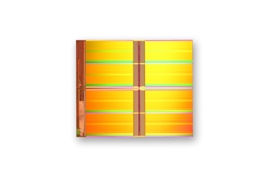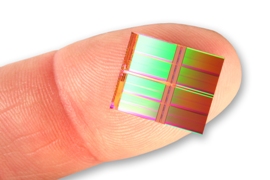
Intel Corporation e Micron Technology hanno annunciato in maniera congiunta la realizzazione di una device NAND Flash di tipo multilevel-cell (MLC) caratterizzata da una densità pari a 128Gb.
In accordo ai chip maker, la nuova soluzione, il cui sviluppo è stato eseguito dalla joint venture IM Flash Technologies (IMFT) da essi composta, permette la realizzazione di package che,
utilizzando soltanto 8 die, consentono la memorizzazione di un terabit (Tb). La dimensione superficiale di un circuito di questo tipo è tale da essere confontabile con la punta di un dito.
La nuova device è stata progettata in maniera conforme con le specifiche ONFI 3.0; di conseguenza, essa è caratterizzata da una velocità misurata in 333 megatransfers per second (MT/s), ovvero
garantisce 333 milioni di trasferimenti al secondo e risulta indicata per l'utilizzo in abbinamento ai tablet, agli smartphone e ad altri sistemi consumer di tipo SFF (Small Form Factor).
In accordo ai produttori, la nuova NAND flash da 128Gb offre prestazioni pari al doppio di quelle esibite dalla soluzione a 20nm e da 64Gb, a proposito della quale è stato ufficializzato da Intel
Corporation e Micron Technology l'avvio della produzione in volumi nel corso del mese corrente.

[Immagine ad alta risoluzione]

[Immagine ad alta risoluzione]

Intel Corporation and Micron Technology, Inc., today announced a new benchmark in NAND flash technology - the world's first 20 nanometer (nm), 128 gigabit (Gb), multilevel-cell (MLC) device. The
companies also announced mass production of their 64Gb 20nm NAND, which further extends the companies' leadership in NAND process technology.
Developed through Intel and Micron's joint-development venture, IM Flash Technologies (IMFT), the new 20nm monolithic 128Gb device is the first in the industry to enable a terabit (Tb) of data
storage in a fingertip-size package by using just eight die. It also provides twice the storage capacity and performance of the companies' existing 20nm 64Gb NAND device. The 128Gb device meets
the high-speed ONFI 3.0 specification to achieve speeds of 333 megatransfers per second (MT/s), providing customers with a more cost-effective solid-state storage solution for today's slim, sleek
product designs, including tablets, smartphones and high-capacity solid-state drives (SSDs.)
"As portable devices get smaller and sleeker, and server demands increase, our customers look to Micron for innovative new storage technologies and system solutions that meet these challenges,"
said Glen Hawk, vice president of Micron's NAND Solutions Group. "Our collaboration with Intel continues to deliver leading NAND technologies and expertise that are critical to building those
systems."
The companies also revealed that the key to their success with 20nm process technology is due to an innovative new cell structure that enables more aggressive cell scaling than conventional
architectures. Their 20nm NAND uses a planar cell structure - the first in the industry - to overcome the inherent difficulties that accompany advanced process technology, enabling performance and
reliability on par with the previous generation. The planar cell structure successfully breaks the scaling constraints of the standard NAND floating gate cell by integrating the first Hi-K/metal
gate stack on NAND production.
"It is gratifying to see the continued NAND leadership from the Intel-Micron joint development with yet more firsts as our manufacturing teams deliver these high-density, low-cost, compute-quality
20nm NAND devices," said Rob Crooke, Intel vice president and general manager of Intel's Non-Volatile Memory Solutions Group. "Through the utilization of planar cell structure and Hi-K/Metal gate
stack, IMFT continues to advance the technological capabilities of our NAND flash memory solutions to enable exciting new products, services and form factors."
The demand for high-capacity NAND flash devices is driven by three interconnected market trends: data storage growth, the shift to the cloud and the proliferation of portable devices. As digital
content continues to grow, users expect that data to be available across a multitude of devices, all synchronized via the cloud. To effectively stream data, servers require high-performance,
high-capacity storage that NAND delivers, and storage in mobile devices has consistently grown with increased access to data. High-definition video is one example of an application that requires
high-capacity storage, since attempting to stream this type of data can create a poor user experience. These developments create great opportunities for high-performance, small-footprint storage,
both in the mobile devices that consume the content and the storage servers that deliver it.
Intel and Micron noted that the December production ramp of their 20nm 64Gb NAND flash product will enable a rapid transition to the 128Gb device in 2012. Samples of the 128Gb device will be
available in January, closely followed by mass production in the first half of 2012. Achievement of this milestone will further enable greater densities and overall fab output, while also helping
the companies' development teams cultivate the expertise required to design complex storage solutions and refine future technologies.
Source: Intel & Micron Technology Press Release
Links



